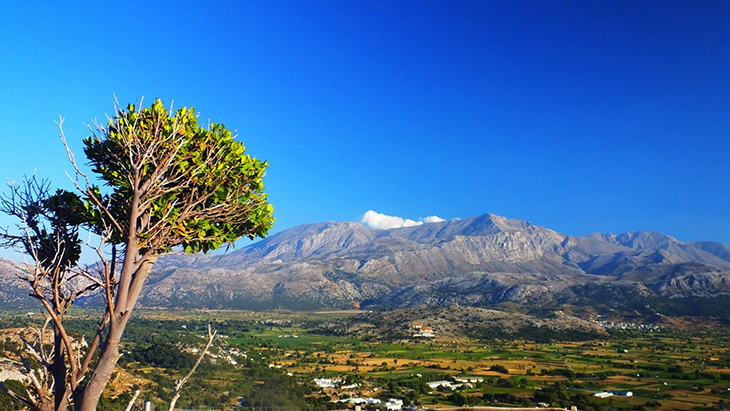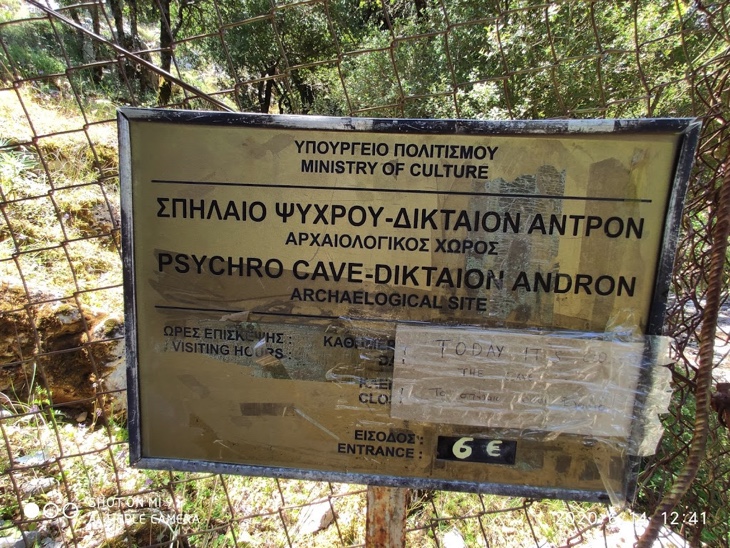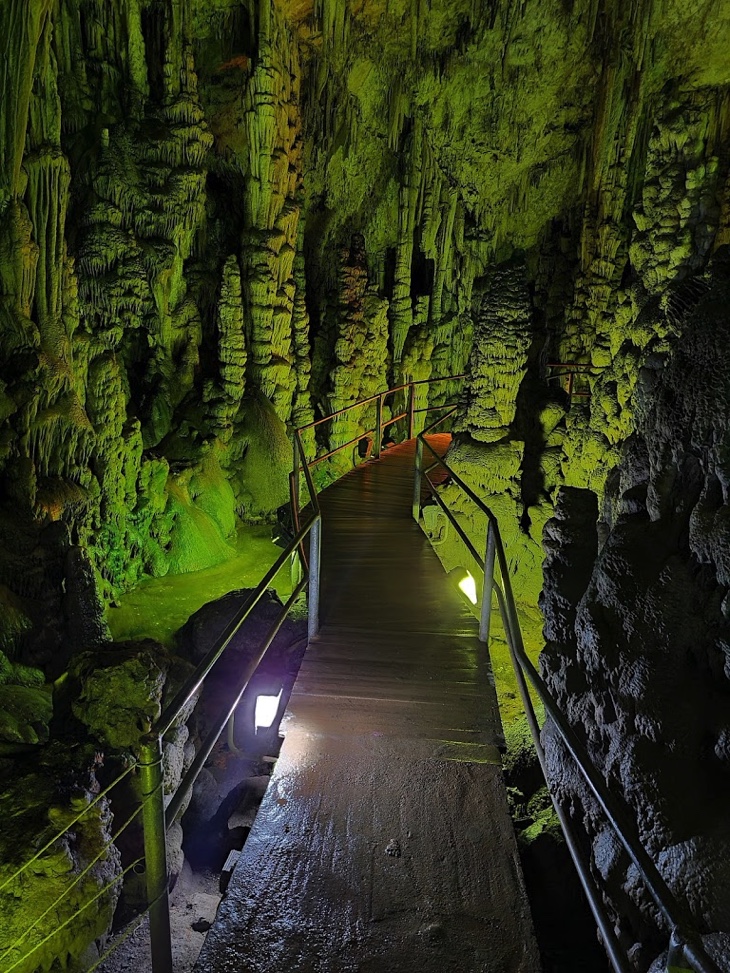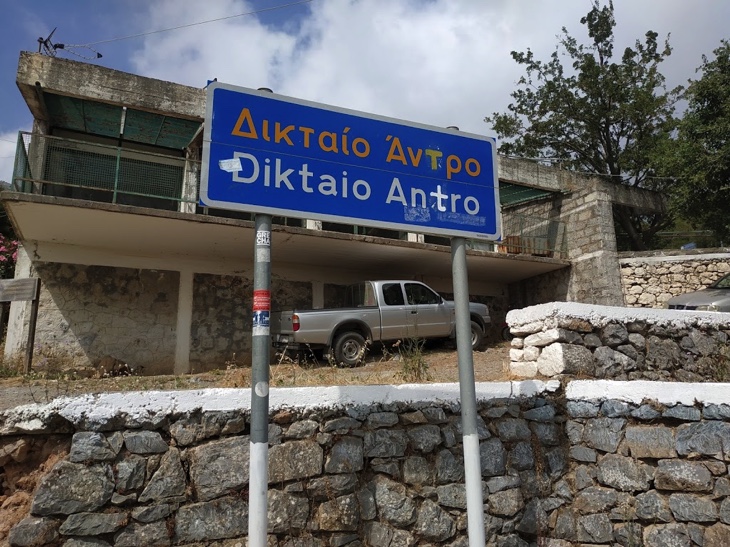Dikteon Cave (Psychro Cave): Known For, Myths, and How to Get There?

Dikteon Cave, locally known as Psychro Cave, is a renowned natural wonder located on the Greek island of Crete. Dikteon Cave is widely recognised for its historical and mythological significance. The cave holds great importance as it is believed to be the birthplace of Zeus, the king of the Greek gods. Rhea, Zeus’ mother, sought refuge in the cave to give birth secretly, according to mythology.
Dikteon Cave is known for its impressive stalagmites and stalactite formations, creating a captivating underground landscape. Visitors need to travel to the village of Psychro, to reach the cafe located on the Lassithi Plateau in East Crete. The journey involves driving along a winding and uphill road, taking approximately 45 minutes to an hour from nearby towns such as Neapoli, Malia, Stalida and Hersonissos.
Visitors must follow the marked path leading to the entrance of Dikteon Cave, one of the caves in the village, where they get to explore the mythical birthplace of Zeus and marvel at the natural wonders within its chambers. People who visit the cave must pay 6 euros for the Psycho Cave tickets.

Bird and bat-inhabited rock formations and an antique altar guard the entrance. A lake and other spectacular stalactites and stalagmites have been lit up for a dramatic effect in one of the cave’s other chambers. The “cloak of Zeus” stalactite, so named because it appears to have been worn away by human hands, is the primary draw of the cave.
What is Dikteon Cave in Crete?
The stunning Dikteon Cave in Greece has attracted visitors from all over the world. The cave is found in the Dikti mountain range, not far from the Psychro hamlet. It is known by several different names such as Diktaion Andron, Dictaean Cave and Psychro Cave. It’s accessible by foot and available to the public. The Dikteon Cave sits at an elevation of around 1025 metres and is most well-known for its association with the ancient Greek god Zeus.
The cave is where Zeus, the supreme deity of the Olympians, was born in Greek mythology. Zeus was concealed and raised by nymphs in order to keep the Greek God out of Cronus’s reach, according to Greek mythology. Legend says that the all-powerful deity was nurtured and prepared for Zeus’ destiny in the caverns of Dikteon. Such a claim is being contested by another cave in Crete, known as Cave Idaion Antros, located at Mt. Ida.
Visitors find the cave’s magical atmosphere and history of association with Zeus fascinating. Dikteon Cave is a well-known tourist destination where sightseers get to marvel at the spectacular stalactite and stalagmite formations inside and learn about the legends that surround such a fabled place. It’s a once-in-a-lifetime chance to get in touch with Greek mythology and witness the ancient marvel that has captivated mankind for millennia.

What is Dikteon Cave known For?
The Dikteon Cave, known as Dikteon Andron or Dictaean Cave, holds a prominent position among the vast number of caves in Crete and Greece, with approximately 3,000 and 8,500 caves, respectively. Its significance lies in its association with the legendary birth of Zeus, making it a site of great renown. The Dikteon Cave or Cave of Zeus, boasts an impressive array of stalagmites and stalactites, creating a visually captivating environment.
Dikteon Cave held immense importance in antiquity and was revered as a sacred space dedicated to the worship of the supreme deity, Zeus, as evidenced by the numerous offerings discovered within its chambers. The ancient allure of the Dikteon Cave, intertwined with its mythical origins, has solidified its reputation as a destination of profound historical and cultural significance.
Archaeological discoveries had revealed evidence of human presence in the cave as far back as the Neolithic Age, when it was already being utilised as a place of worship from the Minoan through the Roman eras. People came from all across Ancient Greece and beyond to worship Zeus and presumably other gods in the cave. The period of its greatest prosperity was the Minoan.

There have been countless discoveries, including ceramics, figurines, weapons, jewels, cereals, needles and Linear A tablets, while many more have been lost due to theft. The artefacts that were salvaged are now on display in museums all around the world, including the Archaeological Museum of Heraklion. It took several years of study and excavations after the cave’s rediscovery in 1883 for its archaeological worth to become apparent.
What is the Myth About Dikteon Cave?
The Dikteon Cave, known to locals as the Cave of Zeus, holds a significant mythological association in Greek mythology. Dikteon Cave is believed to be the birthplace of Zeus, the king of the gods, according to ancient Greek legend. The myth states that Rhea, Zeus’ mother, sought refuge in the Dikteon Cave to protect Zeus from Cronus, who had a habit of devouring one’s own children.
It was believed that Rhea gave birth to Zeus inside the cave and entrusted the Greek God to the care of the nymphs, who raised and nurtured Zeus in secret. The Greek God eventually grew up, overthrew Cronus (Zeus’ father) and became the ruler of the gods. The Dikteon Cave holds a special place in Greek mythology as the sacred birthplace of Zeus, symbolising power, majesty and the beginning of a new era.
Another legend has it that King Minos visited Dictaean Cave every nine years when the moon’s and sun’s orbits converged. King Minos met Zeus and established new laws to govern Crete. The myth is a variant of the prevailing one, both of which relate to the same story about Idean Cave. Another version of the renowned Europa tale claims that when Zeus turned into a bull and charmed Europa, the Greek God did so in the Dictaean Cave rather than Gortyn. Zeus appeared and mated with Europa there. Minos, Sarpedon and Radamanthys were born in Europa.
The ancient Cretan seer Epimenides dozed off for 57 years in the mystical Dictaean Cave. Epimenides remained the same age after awakening, but with a heavenly understanding and wisdom. The Dictaean Cave was the mythical home of the Harpies. The female monsters who carried Hades’ messages had the heads of birds and the bodies of women. The tale of Phineus’s punishment has become legendary.

Where is Dikteon Cave Located in Crete?
The Dikteon Cave, known by its illustrious moniker as the Cave of Zeus, resides in a location of captivating allure, nestled within the majestic Mount Dicte range on the enchanting Greek island of Crete. Specifically situated on the Lassithi Plateau, an idyllic expanse in East Crete, the cave beckons explorers to embark on a journey of discovery. Dikteon Cave is located approximately 50 kilometres (31 miles) southeast of Heraklion, the capital city of Crete. The journey from Heraklion to Dikteon Cave takes about 1.5 to 2 hours by car.
The path to reach the revered Dikteon Cave is an adventure in itself, despite its proximity to towns and popular tourist destinations such as Neapoli, Malia, Stalida and Hersonissos. Reaching the Lassithi Plateau and the village of Psychro, where the entrance to the Dikteon Cave is located, requires driving along a winding and uphill road, although the cave is not a great distance from these locations. Allow approximately 45 minutes to an hour to traverse such a captivating landscape and immerse oneself in the mystical realm of the Dikteon Cave.
What Can You See in the Dikteon Cave?
Someone immediately experiences a noticeable shift in temperature and environment. The absence of sunlight penetration creates a unique atmosphere, characterised by high humidity levels that reach up to 85%. The cave’s interior is enveloped in profound silence, accentuating the tranquil ambience within. Exceptional conditions contribute to the Dikteon Cave’s ecological significance, serving as a vital habitat for a diverse range of animal species.
The antechamber of the cave provides a roosting place for rock doves and various avian creatures, while more profound into the cave, one encounters a plethora of life forms, ranging from arthropods to the presence of the Long-Eared Bat.
Remarkable archaeological discoveries have shed light on its historical significance within the antechamber of the Dikteon Cave. The foundations of a constructed altar, along with remnants of offerings, bear witness to the religious practices that took place within the cave. Devotees presented offerings such as olive oil, honey, wine, wheat and animal sacrifices, which were carefully positioned on the altar and ceremoniously burned.

Even the resulting ashes held sacred value and were not discarded as ordinary refuse; instead, they were reverently collected in close proximity to the altar. The cave’s prolonged and continuous use over time has led to limited space, resulting in numerous finds being repeatedly exposed to fire through successive burnings of offerings on the same altar.
Such extended usage has caused some artefacts to suffer despoliation. Visitors observe the ancient walls of the temenos, the sacred space that delineates the solemnity of such a historic site, as they descend into the cave
How to Get to Dikteon Cave?
Listed below are steps on How to Get to Dikteon Cave.
- The first step is to start at a specific location on the island of Crete.
- Second, determine the nearest town or tourist destination to Dikteon Cave. Recommended towns include Neapoli, Malia, Stalida or Hersonissos.
- Third, arrange transportation, either by renting a car or hiring a taxi, to ensure flexibility and convenience.
- Fourth, set the GPS or map application to navigate to the Lassithi Plateau, located in East Crete. Such a plateau is where Dikteon Cave is situated.
- Fifth, drive along the winding and uphill road that leads to the Lassithi Plateau. Take time and drive cautiously, as the road is challenging.
- Sixth, watch for signs or directions indicating the village of Psychro, where the entrance to Dikteon Cave is located.
- Seventh, find a suitable parking spot near the entrance of Dikteon Cave.
- Next, purchase tickets or pay the entrance fee, if required, at the ticket booth.
- Ninth, follow the designated pathway or trail that leads to the cave entrance. Be mindful of any guidelines or instructions provided by the staff or signs along the way.
- Lastly, enter the cave and enjoy exploring the impressive geological formations and mythical significance of Dikteon Cave.
Hiking to the entrance to the cave takes approximately 15 minutes from the parking lot. Two paths lead to the entrance of the Dikteon Cave, providing visitors with a choice. The left path is considered the easier option, as the stones on the right path, being the oldest, have become worn and slippery from the footsteps of countless tourists. The journey to the cave offers a magnificent experience, with breathtaking views of the Lassithi Plateau regardless of the chosen path. Donkeys are available to transport visitors to the cave for those who prefer not to walk. Adjacent to the cave entrance, a kiosk offers tickets for a nominal fee. The pathways are well-illuminated and thoughtfully designed, extending for a length of 250 metres inside the cave, which spans an area of 2200 square metres.

How Long is the Dikteon Cave?
The Dikteon Cave encompasses an expansive area of 2200 square metres and requires a challenging 1 km uphill trek to reach. Visitors are presented with a unique internal walkway comprising 200 steps descending and another 200 steps ascending once inside the cave. The cave is divided into two distinct sections, namely, the Upper Cave and the Lower Cave. Exploring the mesmerising interior, visitors are treated to a captivating 10-minute journey filled with awe-inspiring stalagmites and stalactites.
Notable archaeological excavations have revealed the presence of a temple featuring an intricately shaped courtyard and a meticulously constructed altar. The Lower Cave is particularly remarkable for its striking stone formations and the presence of a serene pond. A multitude of stalagmites and stalactites, showcasing various shapes, are believed to have served as sacred objects, potentially used in ceremonial practices and serving as gathering points for votive offerings throughout the cave.

How Much is the Tour to the Dikteon Cave?
The cost of Psychro Cave tickets is 6 euros. There are some tours available in Crete where visitors get to visit the Dikteon Cave alongside other tourist spots in Crete. People get to have a glimpse of what is believed to be the birthplace of Zeus inside the cave. Pigeons and other wild birds use the cave’s first chamber as a nesting spot. Many species of bats and cave arthropods are found in the lower Cave. The Dikteon Cave is open from 8 a.m. to 7 p.m. during the summer and from 8 a.m. to 3 p.m. during the winter.
Where to Park in Dikteon Cave?
There are two parking spots at Dikteon Cave. The one below is free, while the one above requires a payment of around 2.50 euros. There are two routes leading up, starting from the upper parking lot. One is near the parking lot. It is made of pebbles and is not very comfortable. The second one is located to the left of the first one and it follows the standard route.

The ascent to the cave takes approximately 15 to 20 minutes. Visitors have the option to hire a donkey to help them get there for 10 euros. There was a steep, paved pathway that visitors needed to ascend for almost one kilometre. The pavement vanishes and becomes rocky as people get closer to the entrance.
The parking space in Dikteon Cave is safe. Dikteon Cave’s parking lot gets crowded during the peak season. Visitors who wish to visit the cave must come early in the morning to secure a parking space and avoid the scorching heat of the sun. Visitors must walk around 15 minutes from the parking area to reach the cave.

What Type of Car Rental Should You Choose when Visiting Dikteon Cave?
An SUV is an ideal ride when visiting the Dikteon Cave. An SUV (Sports Utility Vehicle) provides higher ground clearance and better stability, making it suitable for navigating winding and uphill roads. It offers ample space for passengers and luggage, ensuring a comfortable journey.
Dikteon Cave is found on the Lassithi Plateau, which is situated in East Crete. The Lassithi Plateau is near several towns and tourist destinations, including Neapoli, Malia, Stalida and Hersonissos. Reaching the Lassithi Plateau and the village of Psychro, where the entrance to the Dikteon Cave is located, requires driving along a winding and uphill road, although the cave is not a great distance from these locations. It typically takes around 45 minutes to an hour to reach the cave from nearby areas. Choosing the right car to rent in Crete is essential for a comfortable and enjoyable travel experience on the island.
Where Can I Rent a Car in Crete?
There are several options for renting a car to explore the island at one’s own pace when visiting Crete. Major international car rental companies such as Hertz, Avis and Europcar have branches in Crete, offering a wide selection of vehicles and convenient pick-up and drop-off locations, including airports and city centres.
One notable car rental company in Crete is Rental Center Crete. Rental Center Crete offers a wide range of vehicles to suit various needs and preferences. They have multiple rental locations across the island, including airports, popular tourist areas and city centres, making it convenient for travellers to pick up and drop off their rental cars. Rental Center Crete has been serving visitors to the island for many years, offering a diverse fleet of well-maintained vehicles ranging from compact cars to luxury SUVs.
They have multiple rental locations in popular tourist destinations like Heraklion, Chania, Rethymno and Agios Nikolaos, ensuring easy access for travellers. Their fleet includes a variety of car types, from economy cars for budget-conscious travellers to spacious SUVs for larger groups or families. Rental Center Crete is known for its reliable service, well-maintained vehicles and competitive prices. They even provide additional services such as optional insurance coverage, flexible rental durations and 24/7 customer support.
How to Return the Rental Car?
Listed below is an instructional list describing how to return a rental car.
- Plan ahead. Review the rental agreement to determine the specific requirements and conditions for returning the car. Note the date and time the car needs to be returned.
- Refuel the car. Fill up the gas tank to the level specified in the rental agreement. It is usually a full tank, unless otherwise indicated. Keep the fuel receipt as proof of refuelling.
- Clean the car if it is excessively dirty. Return the car in a reasonably clean condition if it is excessively dirty. Remove any personal belongings and trash from the interior and ensure the exterior is free from excessive dirt or debris.
- Inspect for damage. Conduct a thorough inspection of the car for any new damages or issues. Note any scratches, dents or other damages that were not present when someone initially rented the vehicle. Take photos or videos as evidence, if necessary.
- Return to the designated location. Follow the signs or instructions provided by the rental company to locate the designated return area. It is typically a specific parking lot or area at the rental facility or airport.
- Gather all personal belongings. Ensure that someone removes all personal belongings from the car, including any items that someone has stored in the trunk or glove compartment.
- Return the keys. Park the car in the designated spot and turn off the engine. Lock the car and proceed to the rental counter or kiosk to return the keys.
- Complete the necessary paperwork. Present the rental agreement and any other required documents to the rental staff. They are going to review the condition of the car, process the return and provide customers with a receipt or confirmation of the return.
- Confirm final charges. Verify the final charges on the rental agreement before leaving. Make sure to identify and understand any additional fees or charges and address any concerns or discrepancies with the rental staff.
- Obtain return documentation. Request a copy of the return receipt or any other necessary documents for records purposes. It serves as proof that the customer returned the car on time and in the agreed-upon condition.
When is the Best Time to Visit Dikteon Cave?
The best time to visit Dikteon Cave in Crete depends on personal preferences and the type of experience someone seeks. The summer months (June to August) offer warm and dry weather, making it a popular time to visit. The cave tends to be crowded during such periods. Spring (April to May) and autumn (September to October) provide pleasant temperatures and fewer tourists, making it the best time to explore the cave comfortably.
Consider visiting during the off-peak season (spring or autumn) for a quieter and more peaceful experience. The cave and its surroundings are less crowded, allowing visitors to enjoy a more serene visit. The Dikteon Cave is open during daylight hours and visiting earlier in the day helps visitors avoid larger crowds. The morning or late afternoon light creates beautiful atmospheric conditions inside the cave, enhancing one’s overall experience. The Dikteon Cave is open to visitors regardless of the month’s preference. The cave is open from 8:00 a.m. to 7:00 p.m. during the summer and during the winter, the cave operates from 8:00 a.m. to 3:00 p.m. only. The best time to visit Crete always depends on someone’s personal tastes and preferences.

Which Individual Should Take a Dikteon Cave Tour?
Listed below are the types of individuals who need to take the Dikteon Cave Tour.
- Adventure enthusiasts: The Dikteon Cave tour offers an exciting opportunity to witness the fascinating underground world and its historical significance if someone enjoys exploring unique natural formations and geological wonders
- Nature lovers: The Dikteon Cave is located in the beautiful Mount Dicte range, surrounded by scenic landscapes. The tour is a rewarding experience for someone who appreciates nature’s beauty and wants to experience the breathtaking views of the Lassithi Plateau.
- History and mythology enthusiasts: The Dikteon Cave has significant cultural and mythological importance, as it is believed to be the birthplace of Zeus, the king of the Greek gods. The tour provides valuable insights if someone is interested in Greek mythology and wants to explore historical connections.
- Physically fit individuals: The Dikteon Cave tour involves walking on uneven terrain and climbing stairs. One gets to fully enjoy the tour and navigate through the cave’s passages if they have good mobility and stamina and are comfortable with moderate physical activity.
- Those seeking unique experiences: The Dikteon Cave tour offers a chance to discover a hidden gem and create lasting memories if someone is looking for a memorable and off-the-beaten-path experience during their visit to Crete.
Which Individual Should Not Take the Dikteon Cave Tour?
Listed below is a list of individuals who must not take the Dikteon Cave Tour.
- Individuals with claustrophobia: The Dikteon Cave tour involves navigating through narrow passages and confined spaces. Individuals who experience extreme discomfort or anxiety in enclosed environments find the cave tour challenging and they need to consider their claustrophobia before participating.
- Individuals with respiratory problems: The cave environment has limited ventilation and potentially elevated humidity levels. Individuals with respiratory conditions such as asthma, chronic obstructive pulmonary disease (COPD) or other breathing difficulties must assess their ability to tolerate such conditions before taking the tour.
- Individuals with mobility issues: The Dikteon Cave tour requires navigating uneven surfaces, steps and potentially slippery areas. Individuals with mobility impairments, such as difficulty walking, using stairs or maintaining balance, find it challenging to navigate through the cave and need to assess their physical capabilities before participating.
- Individuals with a history of fainting or dizziness: The tour involves walking on uneven terrain and requires periods of prolonged standing. Individuals who have a history of fainting, dizziness or lightheadedness must consider their susceptibility to such episodes and evaluate whether the physical demands of the tour trigger these symptoms.
Is the Road Safe Drive Going to the Dikteon Cave?
Yes, the road is safe for driving to the Dikteon Cave. The Dikteon Cave is situated within the scenic Mount Dicte range in East Crete, specifically on the captivating Lassithi Plateau. Accessing the Dikteon Cave involves embarking on a picturesque drive towards the Lassithi Plateau. The journey entails navigating a winding and uphill road, while the distance between the towns and the plateau is not extensive in a straight line. Allocating approximately 45 minutes to an hour is advisable to reach the enchanting Lassithi Plateau and the charming village of Psychro, where the captivating Dikteon Cave awaits exploration.
Do Rental Cars Have Insurance?
Yes, rental cars in Crete typically come equipped with insurance coverage. The precise terms and level of coverage differ based on the rental company and the specific insurance package selected. Carefully examine both the rental agreement and insurance policy, taking note of any applicable deductibles or limitations to ensure a comprehensive understanding of the insurance provisions.The standard insurance options for rental cars in Crete encompass Collision Damage Waiver (CDW), Theft Protection (TP) and Third-Party Liability Insurance. There are supplementary insurance alternatives available to augment the coverage or decrease the deductible amount, depending on the rental company. One must become familiar with these options and enable renters to make informed decisions regarding the level of protection desired during their rental period. Tourists who are not familiar with Crete’s local rules must see to it that they abide by them to avoid conflicts and hassles during their stay. Contact the rental company directly or consult their website for detailed information on the car insurance coverage provided for their rental cars in Crete.
Last updated on September 9th, 2023















